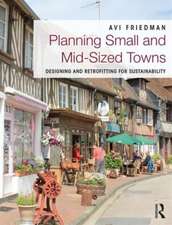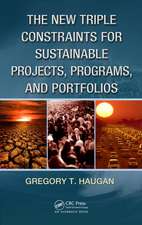The Routledge Handbook of Planning for Health and Well-Being: Shaping a sustainable and healthy future
Editat de Hugh Barton, Susan Thompson, Sarah Burgess, Marcus Granten Limba Engleză Hardback – 12 iun 2015
The Routledge Handbook of Planning for Health and Well-being authoritatively and comprehensively integrates health into planning, strengthening the hands of those who argue and plan for healthy environments. With contributions from international leaders in the field, the Handbook of Planning for Health and Well-being provides context, philosophy, research, processes, and tools of experienced practitioners through case studies from four continents.
| Toate formatele și edițiile | Preț | Express |
|---|---|---|
| Paperback (1) | 352.09 lei 43-57 zile | |
| Taylor & Francis – 28 apr 2017 | 352.09 lei 43-57 zile | |
| Hardback (1) | 1226.05 lei 43-57 zile | |
| Taylor & Francis – 12 iun 2015 | 1226.05 lei 43-57 zile |
Preț: 1226.05 lei
Preț vechi: 1639.97 lei
-25% Nou
Puncte Express: 1839
Preț estimativ în valută:
234.60€ • 245.60$ • 194.12£
234.60€ • 245.60$ • 194.12£
Carte tipărită la comandă
Livrare economică 07-21 aprilie
Preluare comenzi: 021 569.72.76
Specificații
ISBN-13: 9781138023307
ISBN-10: 1138023302
Pagini: 652
Ilustrații: 14 black & white tables, 108 black & white halftones, 106 black & white line drawings
Dimensiuni: 174 x 246 x 33 mm
Greutate: 1.37 kg
Ediția:1
Editura: Taylor & Francis
Colecția Routledge
Locul publicării:Oxford, United Kingdom
ISBN-10: 1138023302
Pagini: 652
Ilustrații: 14 black & white tables, 108 black & white halftones, 106 black & white line drawings
Dimensiuni: 174 x 246 x 33 mm
Greutate: 1.37 kg
Ediția:1
Editura: Taylor & Francis
Colecția Routledge
Locul publicării:Oxford, United Kingdom
Public țintă
Postgraduate and UndergraduateCuprins
List of figures, List of contributors, Acknowledgements, Foreword by Agis Tsouros, Introduction, PART I: Perspectives, 1. Planning for health and well-being: the time for action, 2. Integrating health into town planning: a history, 3. Urban inequities, population health and spatial planning, 4. Rapid urbanisation, health and well-being: how informal settlements, slums and sprawling suburbs are globalising health problems, 5. Healthy cities, healthy planet: towards the regenerative city, 6. Mind the gap: bridging the divide between knowledge, policy and practice, PART II: The human experience, 7. Health inequalities and the role of the physical and social environment, 8. Active travel: its fall and rise, 9. The influence of urban design and planning on physical activity, 10. Healthy play for all ages in public open spaces, 11. Mental well-being and the influence of place, 12. Crime and community safety: challenging the design consensus, 13. The role of planning and design in advancing a bio-nutrition-sensitive food system, PART III: The human habitat, 14. Obesogenic built environment: concepts and complexities, 15. Settlement patterns, urban form and travel, 16. Retrofitting suburbia for health: scenarios for neighbourhood planning, 17. Beyond the park: linking urban greenspaces, human well-being and environmental health, 18. Hotter cities: climate change and planning for resilient, healthy urban environments, 19. Housing, energy efficiency and fuel poverty, 20. The spatial determinants of air quality, 21. Water management, urban development and health, PART IV: Processes and tools, 22. The co-benefits framework for understanding and action on climate change, 23. Delivering healthy places: the role of the private sector, 24. Building collaborative partnerships, 25. Creating healthier, smarter places: learning from European cities, 26. Assessing the potential health effects of policies, plans, programmes and projects, 27. A strategic approach to green infrastructure planning, 28. Healthy housing, 29. Community housing and place-making: narratives, forms and processes for convivial living, 30. Local management of energy demand and supply, PART V: Healthy planning in global practice, 31. Healthy planning in Australia, 32. Planning for resilient cities: lessons from post-earthquake Canterbury, 33. The development of a healthy ageing programme in Taiwan, 34. Managing city development for health in India: the case of Hyderabad city, 35. The integration of health into planning in Turkish cities, 36. Health-integrated planning and appraisal in the English Midlands, 37. The three fabrics strategy in Finland, 38. Freiburg: green capital of Europe, 39. Public realm and public health in North American cities: reshaping cities to encourage and enable active travel, 40. Planning a healthy city: progress and challenges in Portland, Oregon, 41. Designing for conviviality and city vitality in Portland, Epilogue, Acronyms, Index
Recenzii
"This is a manifesto for how we should plan our neighbourhoods, towns and cities. It champions the objectives of health and well-being - time-honoured values in the history of planning - as the core means to achieving well-made, rich, beautiful and happy places. I'd like to see every politician, planner and developer given a copy. I'd like every household in the country to understand its message."
—Kevin McCloud, MBE
"This book will be a valuable resource for urban planners and design professionals as well as public helaht professionals and others interested in improving the health and wellbeing of the increasing majority of the world's people who are city dwellers."
—Trevor Hancock, Professor and Senior Scholar, School of Public Health and Social Policy, University of Victoria, Australia
"The Routledge Handbook of Planning for Health and Well-Being is an amazing resource to guide users in addressing health concerns at their source by providing discussions of various habitats, processes and tools for promoting healthy communities, and case studies from around the globe."
—Nisha D. Botchwey, PhD, MCRP, MPH, Georgia Institute of Technology, USA
"I welcome this book as a major step in taking forward the implementation of the healthy cities vision. Planning for health and well-being is a discipline-defining publication. It is the first in this field oriented around the needs of planning professionals and academics. It is extensive and authoritative, yet accessible in style and language. If you believe in an ethical and inspiring basis for urban planning, read it . Use it." - Agis Tsouros, Director, Policy and Governance for Health and Well-being, World Health Organization, Regional Office for Europe – in the Preface.
"This comprehensive volume on health and planningis without peer – international in scope and outstanding in scholarship. It re-joins planning to its original reformist twin, health, at a time of grave threat to human well-being in an urban age. A compelling and timely contribution."
—Professor Brendan Gleeson, Director, Melbourne Sustainable Society Institute, The University of Melbourne, Australia
"This book confirms the vital role that town planning has in making people’s lives healthier and happier. It provides clear evidence about the kinds of action we can take now to secure people’s well-being and reduce long term social care costs. This is simply a vital book for any practitioner interested in the future health and well-being of their community."
—Dr. Hugh Ellis, Head of Policy, Town and Country Planning Association, UK
"What does a healthy and sustainable city look like? It is a city of short ways, where all daily requirements are available within walking distance. It is a city which is socially cohesive, equitable, and values the natural environment. The principles are widely advocated, but most cities and countries are still going blindly in the opposite direction. This huge book from internationally-respected authors issues an urgent call to action. It providing a wealth of scientific evidence and practical exemplars to convince policy-makers they must change. It also has massive implications for the way we train built environment professionals: putting people first; putting health at the heart of planning."
—Wolf Daseking, former Chief Planner, Freiburg, Germany
"It is a remarkable fact that our Victorian forebears worked out that health and planning were inextricably linked. The great schemes of sanitation and urban improvement which had such tangible beneficial effects on the health of the population stand as a monument to their vision and practical problem solving. How did we lose our way? How did we arrive at a situation where planning and public health became so disjoined? In this excellent new book the authors point us in a direction which shows what can and could be achieved in the contemporary age. It is a landmark text which will be highly influential in the years to come."
—Mike Kelly, Institute of Public Health, University of Cambridge, UK, and former Director of the Centre for Public Health at NICE
—Kevin McCloud, MBE
"This book will be a valuable resource for urban planners and design professionals as well as public helaht professionals and others interested in improving the health and wellbeing of the increasing majority of the world's people who are city dwellers."
—Trevor Hancock, Professor and Senior Scholar, School of Public Health and Social Policy, University of Victoria, Australia
"The Routledge Handbook of Planning for Health and Well-Being is an amazing resource to guide users in addressing health concerns at their source by providing discussions of various habitats, processes and tools for promoting healthy communities, and case studies from around the globe."
—Nisha D. Botchwey, PhD, MCRP, MPH, Georgia Institute of Technology, USA
"I welcome this book as a major step in taking forward the implementation of the healthy cities vision. Planning for health and well-being is a discipline-defining publication. It is the first in this field oriented around the needs of planning professionals and academics. It is extensive and authoritative, yet accessible in style and language. If you believe in an ethical and inspiring basis for urban planning, read it . Use it." - Agis Tsouros, Director, Policy and Governance for Health and Well-being, World Health Organization, Regional Office for Europe – in the Preface.
"This comprehensive volume on health and planningis without peer – international in scope and outstanding in scholarship. It re-joins planning to its original reformist twin, health, at a time of grave threat to human well-being in an urban age. A compelling and timely contribution."
—Professor Brendan Gleeson, Director, Melbourne Sustainable Society Institute, The University of Melbourne, Australia
"This book confirms the vital role that town planning has in making people’s lives healthier and happier. It provides clear evidence about the kinds of action we can take now to secure people’s well-being and reduce long term social care costs. This is simply a vital book for any practitioner interested in the future health and well-being of their community."
—Dr. Hugh Ellis, Head of Policy, Town and Country Planning Association, UK
"What does a healthy and sustainable city look like? It is a city of short ways, where all daily requirements are available within walking distance. It is a city which is socially cohesive, equitable, and values the natural environment. The principles are widely advocated, but most cities and countries are still going blindly in the opposite direction. This huge book from internationally-respected authors issues an urgent call to action. It providing a wealth of scientific evidence and practical exemplars to convince policy-makers they must change. It also has massive implications for the way we train built environment professionals: putting people first; putting health at the heart of planning."
—Wolf Daseking, former Chief Planner, Freiburg, Germany
"It is a remarkable fact that our Victorian forebears worked out that health and planning were inextricably linked. The great schemes of sanitation and urban improvement which had such tangible beneficial effects on the health of the population stand as a monument to their vision and practical problem solving. How did we lose our way? How did we arrive at a situation where planning and public health became so disjoined? In this excellent new book the authors point us in a direction which shows what can and could be achieved in the contemporary age. It is a landmark text which will be highly influential in the years to come."
—Mike Kelly, Institute of Public Health, University of Cambridge, UK, and former Director of the Centre for Public Health at NICE
Descriere
The Routledge Handbook of Planning for Health and Well-being authoritatively and comprehensively integrates health into planning, strengthening the hands of those who argue and plan for healthy environments. With contributions from international leaders in the field, the Handbook of Planning for Health and Well-being provides context, philosophy, research, processes, and tools of experienced practitioners through case studies from four continents.














